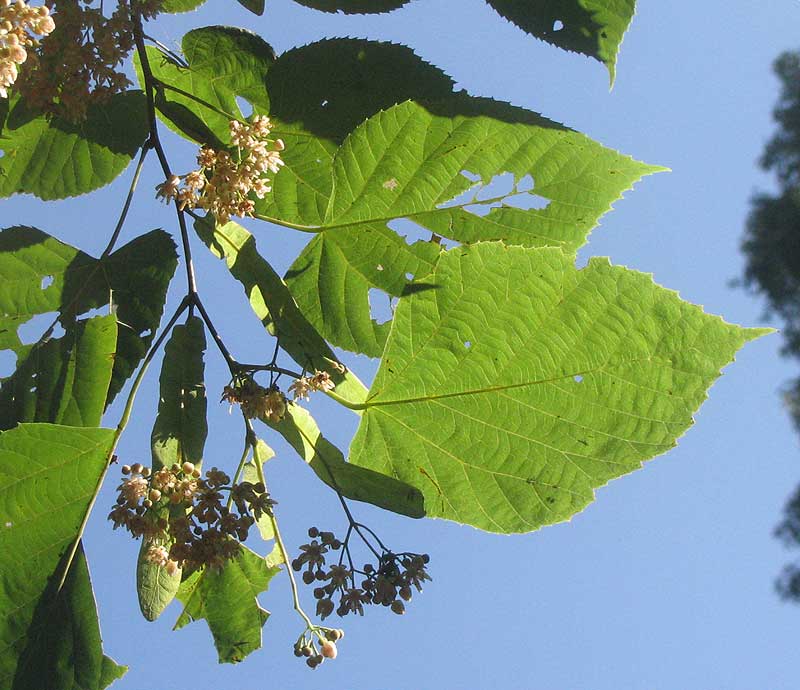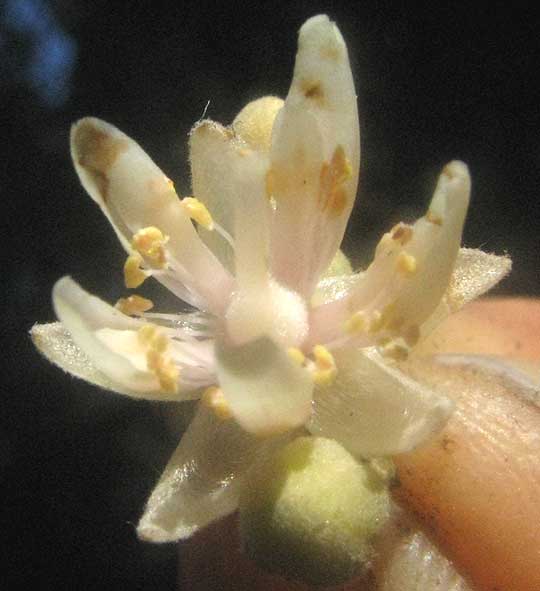Excerpts from Jim Conrad's
Naturalist Newsletter

from the June 24, 2012 Newsletter issued from the woods of the Loess Hill Region a few miles east of Natchez, Mississippi, USA
BASSWOOD FLOWERING
Nowadays the Basswoods, TILIA AMERICANA, are very prettily flowering, as shown above. If you're unfamiliar with the Basswood's unusual manner of presenting its flower clusters, be sure to notice in the above picture how each cluster of creamy-white blossoms dangles from a stem, or peduncle, that is not attached to the stem in the normal manner, but rather connects to the center of the midrib of a flat, fingerlike, green blade very unlike the big leaves, and that this strange blade itself arises from the angle between the petioles of the regular leaves and the stem, where flower clusters usually arise. A close-up showing this remarkable construction from a different angle is seen below:

The fingerlike items the flower clusters arise from are bracts, which are modified leaves. Over the years we've seen many kinds of bracts doing extraordinary service -- such as the spectacularly large, red ones surrounding the Poinsettia's tiny, inconspicuous flowers. The Basswood's bracts are just as amazing.
Basswood flowers themselves are a little unusual, as shown below:

There you can see a fairly normal but fuzzy, oval ovary in the flower's center, with its stigma-tipped style rising vertically. Below the ovary numerous male stamens arise with their yellowish anthers shedding pollen. Below the ring of stamens there are five petals, and alternating with them are five white, fuzzy, petal-like sepals. That's all normal, but if you look closely at the petals, particularly the topmost one, you'll see what looks like a second, smaller white petal arising between it and the ovary. This is what's unusual. These "smaller inner petals" are actually modified stamens called staminodia, and they're regular features in flowers of the many basswood species. I can't imagine why the flower thinks it needs them.
Basswoods are big trees up to 80 feet tall (24m), typically well formed and pleasing to look at, and especially handsome with those large, thin, heart-shaped leaves with serrated margins. Nowadays their abundant flowers keep the trees abuzz with pollinators. Basswood honey is among the best tasting. Standing beneath a tree with sunlight filtering through the thin leaves while all that pollination activity goes on is a delicious experience itself.
Basswoods are uncommon in this area and I suspect that the reason is because their wood is especially light, strong, and beautiful. I'll bet that they, like White Oak and other highly valued hardwoods, have been "harvested" to the point of local extinction.
The "bass" in the name basswood derives from the word "bast," one definition of which is "fibrous material obtained from the phloem of jute, hemp, flax, lime, etc., used for making rope, matting, etc." That makes sense when we read that the Basswood's inner bark contains such tough fibers that in the past ropes were made from it. It also makes sense that basswood inner bark would be so fibrous, since basswoods are member of the Hibiscus Family, and in recent times we've focused on the tough fibers of several species in that family traditionally used by the Maya and others as rope.
Basswoods are often called Lindens. You may have enjoyed herbal tea in which "dried Linden flowers" were an important ingredient. Dried basswood flowers contain plenty of aromatic volatile oils that taste good to humans. They also contain flavonoids which act as antioxidants, and mucilaginous agents that soothe and reduce inflammation. The list of ailments Linden flower tea is good for is too long to list. What a wonderful plant.
Basswood taxonomy is in mess. Mainly, the experts can't agree on whether there's one big, variable species occurring throughout nearly all of the forested, eastern US and adjacent Canada, or whether some of the variations are distinct species. Wikipedia presents them as different species but Weakley's online Flora of the Southern and Mid-Atlantic States points out that the variations "are imperfectly distinct in geographic areas of overlap," and treats them all as one species. That's how I'm treating ours -- as Tilia americana var. caroliniana, sometimes separated as the Carolina Basswood, Tilia caroliniana.